|
"I
started crying. It
was amazing. I never thought that would happen."
Thick-necked and spiky-haired, Mike Mushok doesn't look like much
of a weeper. But when Staind's latest album, Break the Cycle, entered
Billboard's Top 200 chart at number one, the guitarist found
himself blubbering like a beauty contest winner. "We
found out how well the album had done the first day it was
released," he recalls. "People at the label started throwing
around these ridiculous numbers. We just said, 'Let's see what happens
in a week.'"
"It's
Been Awhile" comes on the heels of another acoustic-based
number-one hit for Staind, Lewis' live rendition of "Outside"
from the 1999 Family Values tour CD. But wait. Where have we heard
this story before? Ferocious metal band breaks into the pop mainstream
with a heart-on-its-sleeve slow song? Could this be a new incarnation of
that Eighties metal mainstay, the power ballad? Mushok seems appalled
at the suggestion. "I
don't think so. They're not love songs. 'It's Been Awhile' just touches
a lot of people. I'm real proud of the way it turned out." Other
songs on Break the Cycle also find Lewis moving beyond anger.
Rather than throwing teenage hate tantrums, he seems to be reflecting on
the quiet desperation of adult life. Some songs hint that the
29-year-old singer is slightly uncomfortable with his role as spokesman
for alienated adolescents. "Waste" deals with a real-life
incident where Lewis was confronted by the mother of a young Staind fan
who had committed suicide, the distraught woman looking to the singer
for "answers only she should know." Then
there's the fact that—unlike many of his nu-metal brethren—Lewis can
do more than just scream. He can actually carry a tune, conveying his
angst in an expressive, grunge-inflected baritone. All of which helps
build a case for Break the Cycle as the harbinger of a new phase
in nu-metal—a move beyond the pissed off histrionics and
misappropriated gangsta outrage of acts like Limp Bizkit, Slipknot, Korn
and their innumerable imitators. Still hard edged, but more–dare we
say it?—mature. "All
we set out to do when we wrote this record was to focus on melody,"
says Mushok. "Not only in the vocals but in the music also. What I
try to do in coming up with the songs and parts is to make a melodic
background for Aaron to do what he does best."
It was
around this time that Mushok discovered he likes his guitars tuned low
and alternately. "It came from being bored with playing a regularly
tuned guitar or a dropped-D guitar," he says. "I saw the guys
in Korn were using a seven-string. And I remembered Steve Vai used to
play one too. I thought it was cool, but I didn't have a seven-string at
the time. Plus I have pretty small hands. So I figured I'd take the high
string off my guitar and add a low B string. And with that, I started
playing around with different tunings, trying to come up with
interesting chord voicings. If a chord sounded nice to me, I would try
to put a progression together and base a song on that. I started out as
a very schooled player. But now I can't even tell you what key any of
our songs are in. I don't know the chords that I'm playing." Although
he's flirted with a few different brands of baritone guitars, including
ones built by L.A. luthier Ralph Novax, Mushok's main passion is for
low-slung Ibanezes: "I have an old Ibanez Artist from the early
Eighties. And that was what I had chosen for the B tuning I use. I use a
.75 gauge bass string for the low B. There's a custom bridge and nut.
Even the tuning peg has to be drilled out so a .75 gauge string can go
through it." Staind's
1996 self-released first album, Tormented, sold only a few
thousand copies. But it took the band to the next stage of its career.
Well, actually, it was many of the same stages, but at least Staind
didn't have to play covers anymore. "We had built up enough of a
following playing covers and originals that we would still sell out the
same clubs just playing our own music," says Mushok.
"In
my mind that was the wisdom that we took away after working with
Fred in Jacksonville," says Mushok. "We went back to Springfield
and wrote 'Just Go,' 'Home,' 'Me' and some of the other songs from the Dysfunction
record [1999]. I think it was at that point that we started
to become more dynamic too. That was another thing we walked away with
after working with Fred that first time." Durst
produced Staind's major-label debut, the aforementioned Dysfunction, which
became a major chart success thanks, in part, to the hit single "Mudshovel."
But in making Break the Cycle, the band moved out of Durst's
shadow a little bit, opting instead to work with producer Josh Abraham. "We
really wanted to write the record ourselves and see what we could
do," says Mushok. "But it really wasn't a move away. Fred came
down to the studio at the end. He had some suggestions. It was kind of
like the father figure going, 'You know, you guys are good.'" An
inveterate workaholic, Mushok got Staind busy on Break the Cycle just
a week after they group finished touring behind Dysfunction. "I
had all these song ideas from being on the road," he explains.
"I always carry a little cassette recorder with me. On the tour
bus, after a show, I would climb into my bunk with a guitar and a headphone
amp and just play. Whenever I came up with anything I liked, I'd take
the headphones off and put them around the condenser mic on this
little tape recorder. A lot of songs on this album came from listening
back to those tapes. Like the song 'Can't Believe.' I was listening back
to a tape one day and heard that little clean guitar riff. I didn't even
remember playing or recording it. I had to go back and relearn it. And
within a half hour I had the whole song written. "So once I
started working on these song ideas, the floodgates opened. I started to
get overwhelmed because I had so many ideas going on. I felt like, 'I
need to share this with the band. We need to start putting this together
and making sure that everybody's happy
with these arrangements.'"
Given
the nature of the material, Mushok found himself developing more clean
tones for Break the Cycle than he had for Dysfunction. "Josh
and I spent a lot of time on the tones," he says. "We were
really happy with the clean tone out of a Deizel amplifier I've been
using, The
album also offers up a palette of flanged guitar sounds – a direction
Mushok first hinted at on "Mudshovel," from Dysfunction. "Actually,
there are no effects at all on 'Mudshovel'," he says. That flanging
sound is just a sliding harmonic between the first and second fret, up
to the fourth and fifth fret, back and forth. And underneath that I did
an EBow thing that's a harmonic type of note. But on this new album,
Josh had a huge box of pedals. I'm not a real big pedal guy, but I
know we ended up using one of those old-school ADA flangers, a lot of
Ibanez pedals and some old MXR stuff." But the
flanging on "Open Your Eyes," Mushok adds, was from a Pro
Tools plug in. "That song was the last one that got finished, down
in Miami, right before Christmas. Originally, the music for the verses
in that song was completely different. I liked it, but I wasn't sure
if it was right. And Aaron never sang anything over it that was really
definitive. One day, when Aaron was out of the studio having lunch, I
had Josh put the song up and I basically rewrote the music to the bass
line and drums that were already there. Actually, we ended up doctoring
the bass line a little bit in Pro Tools. One of the notes didn't fit, so
we had to cut it up. And while we were in Pro Tools, we put that flanged
sound on it." While Break
the Cycle was sitting on top of the Billboard Top 200, Staind
was patiently working its way through an American tour that included
clubs and midsize venues as well as the occasional stadium. "It's
all good," says Mushok stoically. But
hasn't anything changed for the band since Break the Cycle hit
the top? "Well, we're playing later in the day at these radio shows," the guitarist laughs. "But yeah, it has gotten different. It's a little more intense now. The response is pretty amazing." ---------------------
MIKE MUSHOK Yeah, I think it's great. People
talk about this resurgence of rock. But to me, rock never went away. I
think the media and corporate America try to put a twist on things.
Everybody's trying to say what the next big thing is. But it's
ridiculous to say rock is the next big thing when rock was always there. GW Describe your personal agenda as a player. MUSHOK My personal agenda is to write good songs and to grow
as a musician and songwriter. For me, the guitar isn't what it used to
be. When I was younger I would practice all the time and work on my
chops. Now when I play it's more to write music rather than to work on
my technique. GW Name one classic and one contemporary player that have
great guitar tones. MUSHOK The classic guy would be Eddie Van Halen. Major guitar
player, major guitar tone. Up until the 1984 album, anyway. As
for contemporary players, Adam Jones from Tool has a great tone. GW Who was your primary guitar inspiration? MUSHOK Tony McAlpine. I took lessons from him before I joined
Staind. The guy changed my life. He really made me look at the guitar
differently. I'd been playing for a long time before I met him, but
afterward I became completely obsessed with the guitar to the point
where my mother would say, "Put down that guitar, get out of this
house and go do something." GW What would you say is your personal best recorded
performance? " MUSHOK I'm really happy with "Fade," from Break the Cycle. There are a lot of cool things going on, from the flanged-out harmonics in the background to the strummed clean chords to the octave thing that's going on in the chorus. And I love the dynamics—the huge chorus, then just a strummed, shimmering chord. It breaks down to almost nothing. And the way it comes out of the bridge—what Aaron [Lewis] did, vocally, going into that last chorus. The first time I heard that, I got goose bumps. |

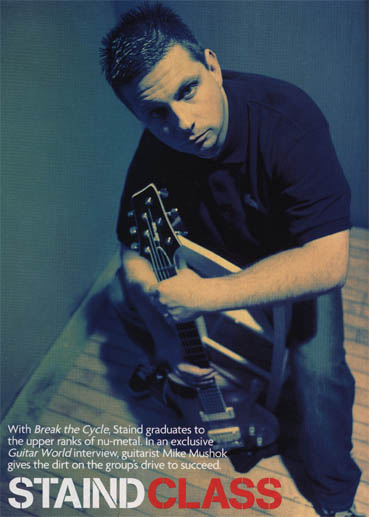 What
happened was that Break the Cycle sold an awe-inspiring 716,000
copies, the second highest first-week sales of any album so far this
year. A bruising quartet out of Springfield, Massachusetts, Staind can
roar and rage with the best of the nu-metal pack. But what vaulted them
out of the Modern Rock/Mainstream Rock ghetto and landed them atop the Billboard
charts was the acoustic guitar-driven ballad "It's Been
Awhile." The track finds Staind singer Aaron Lewis ruminating on
past pain, self-loathing and addiction, owning up to his significant
other and saying, "I'm sorry."
What
happened was that Break the Cycle sold an awe-inspiring 716,000
copies, the second highest first-week sales of any album so far this
year. A bruising quartet out of Springfield, Massachusetts, Staind can
roar and rage with the best of the nu-metal pack. But what vaulted them
out of the Modern Rock/Mainstream Rock ghetto and landed them atop the Billboard
charts was the acoustic guitar-driven ballad "It's Been
Awhile." The track finds Staind singer Aaron Lewis ruminating on
past pain, self-loathing and addiction, owning up to his significant
other and saying, "I'm sorry."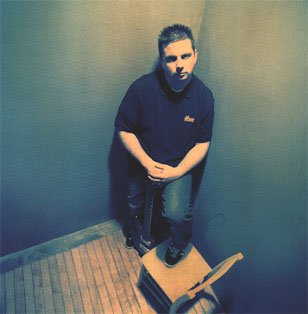 Melody
wasn't quite as high on the agenda when Staind first started
rehearsing in the basement at the home of Mushok's parents. "When
this band started in 1995, Springfield was the home of the tribute
band," says the guitarist. "We got together, wrote some original
tunes and decided we wanted to play out.
Melody
wasn't quite as high on the agenda when Staind first started
rehearsing in the basement at the home of Mushok's parents. "When
this band started in 1995, Springfield was the home of the tribute
band," says the guitarist. "We got together, wrote some original
tunes and decided we wanted to play out.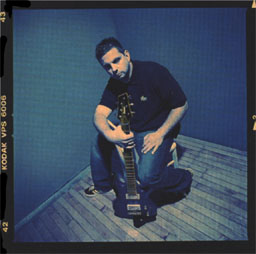 Tormented
is also notable for having aroused the moral indignation of Fred
Durst. The album cover's images of a Bible impaled on a dagger and
Barbie crucified upside down were too much for the man whose fame rests
on his ability to say "fuck" more times than anyone else. But
once Durst heard Staind play live, he found it in his heart to forgive
them their blasphemy. He took the band members under his wing,
inviting them down to his Jacksonville, Florida, headquarters for a
little A&R-ing. It was Durst who encouraged Staind to make greater
use of the more melodic aspects of Lewis' voice. Prior to this, the
Staind vocalist had been doing more screaming. No mean screamer himself,
Durst heard Lewis and realized, "Hey this guy can really
sing."
Tormented
is also notable for having aroused the moral indignation of Fred
Durst. The album cover's images of a Bible impaled on a dagger and
Barbie crucified upside down were too much for the man whose fame rests
on his ability to say "fuck" more times than anyone else. But
once Durst heard Staind play live, he found it in his heart to forgive
them their blasphemy. He took the band members under his wing,
inviting them down to his Jacksonville, Florida, headquarters for a
little A&R-ing. It was Durst who encouraged Staind to make greater
use of the more melodic aspects of Lewis' voice. Prior to this, the
Staind vocalist had been doing more screaming. No mean screamer himself,
Durst heard Lewis and realized, "Hey this guy can really
sing."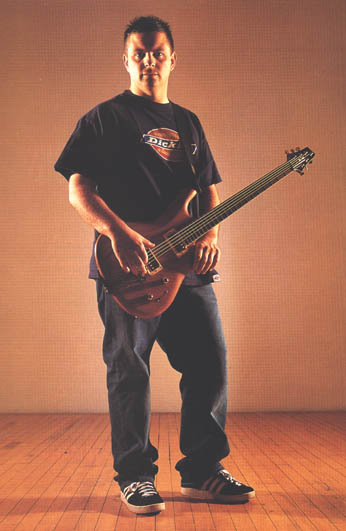 Like
"Outside" before it, "It's Been Awhile" grew out of
a melody and chord progression that Lewis had developed on acoustic
guitar. "It didn't have the bridge section that's there now,"
Mushok recalls. "We put that together when we arranged the song as
a band. I got a little carried away with guitar parts in the studio,
actually. Beside the acoustic guitar track, there's two distinct other
rhythm tracks doing completely opposite things. Then there's this
single-note thing going through the verses and this octave figure in
the chorus and bridge."
Like
"Outside" before it, "It's Been Awhile" grew out of
a melody and chord progression that Lewis had developed on acoustic
guitar. "It didn't have the bridge section that's there now,"
Mushok recalls. "We put that together when we arranged the song as
a band. I got a little carried away with guitar parts in the studio,
actually. Beside the acoustic guitar track, there's two distinct other
rhythm tracks doing completely opposite things. Then there's this
single-note thing going through the verses and this octave figure in
the chorus and bridge."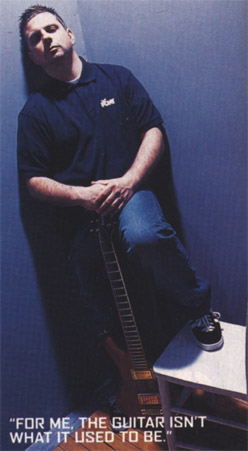 GUITAR WORLD
GUITAR WORLD